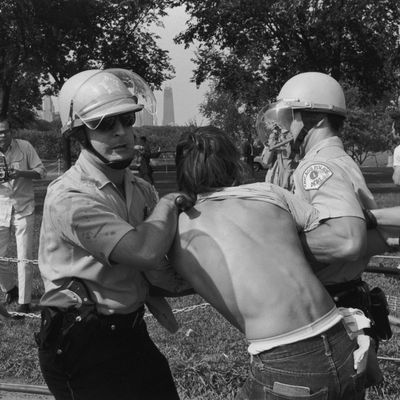
One of the most fascinating developments surrounding the George Floyd protests has been a steady shift in media and public focus from misconduct by protesters (e.g., property damage and looting) to misconduct by the police who are visibly and violently confronting protesters (and reporters, and bystanders) in a way that doesn’t promote the restoration of order. Jamelle Bouie has rightly called what’s happening in many places “police rioting”:
Rioting police have driven vehicles into crowds, reproducing the assault that killed Heather Heyer in Charlottesville, Va., in 2017. They have surrounded a car, smashed the windows, tazed the occupants and dragged them out onto the ground. Clad in paramilitary gear, they have attacked elderly bystanders, pepper-sprayed cooperative protesters and shot “nonlethal” rounds directly at reporters, causing serious injuries. In Austin, Texas, a 20-year-old man is in critical condition after being shot in the head with a “less-lethal” round. Across the country, rioting police are using tear gas in quantities that threaten the health and safety of demonstrators, especially in the midst of a respiratory disease pandemic.
The idea of a “police riot” is galvanizing for the obvious reason that agents of the state who have been given a monopoly on the legitimate use of deadly force are deploying it for illegitimate purposes that turn the concept of “peace officers” upside down. The fear inspired by “rogue cops” in general is illustrated by their ubiquity as bad guys in hundreds of books, movies, and TV shows. Nothing’s much scarier than cops who go “rogue” in order to physically attack people they are sworn to protect.
Bouie rightly traces the habit of excessive force displayed against African-Americans as a legacy of the racist social-control function police departments were expected to perform whenever it was feared black folks were getting out of line. But African-Americans have not been the only targets of “police riots.” Indeed, the event that inspired the first generally known use of that term was the violence surrounding the 1968 Democratic National Convention, where largely white antiwar protesters were brutalized by Chicago police.
After the intense protests earlier that year following the assassination of Martin Luther King Jr., President Lyndon Johnson appointed a blue-ribbon Commission on the Causes and Prevention of Violence. It authorized a report on the DNC violence from local businessman Daniel Walker, who penned these headline-grabbing lines:
[O]n the part of the police there was enough wild club swinging, enough cries of hatred, enough gratuitous beating to make the conclusion inescapable that individual policemen, and lots of them, committed violent acts far in excess of the requisite force for crowd dispersal or arrest. To read dispassionately the hundreds of statements describing at firsthand the events of Sunday and Monday nights is to become convinced of the presence of what can only be called a police riot.
While the Walker report infuriated Chicago cops and their boss, Mayor Richard Daley, it helped turn Walker into a political figure who was elected governor of Illinois four years later on an anti-Daley “reform” platform (defeating Daley’s candidate, Paul Simon, later a progressive icon, in the Democratic primary). Part of what made Walker’s account widely credible, and a bit of common ground with the George Floyd protests, was the fact that so many Americans saw the police misconduct, since it was adjacent to a party convention at a time when all three broadcast networks still provided “gavel-to-gavel” coverage of these events. Indeed, one of the enduring Chicago protest slogans was: “The Whole World’s Watching.” And like the police in many of the current protests, the Chicago cops in 1968 targeted news cameras and reporters for abuse along with the “radical” antiwar demonstrators.
Something that separated the DNC protests from most of those following George Floyd’s death is that they were nationally organized well in advance (mostly by the National Committee to End the War in Vietnam, the largest student-based antiwar organization, and the Youth International Party, a.k.a. the yippies). Thus the protesters were perceived by the Chicago authorities as “outsider agitators”; some of the police tactics were aimed at forcefully preventing demonstrators from linking up with local African-American activists. Without question, there was an element of class antagonism among the blue-collar cops toward the “pampered” college students who had the time and resources to come to Chicago to “cause trouble.”
So far, the George Floyd protests and the police reaction to them have united, rather than divided, the Democratic Party (and the GOP, as well, to the extent that Republicans follow their leader’s erratic behavior). That wasn’t the case in 1968. The protesters were implicitly challenging the nomination of Vice-President Hubert Humphrey, at that point a loyal supporter of Lyndon Johnson’s war.
Perhaps the most vivid moment of the convention occurred when Connecticut senator Abraham Ribicoff, in a nominating speech for George McGovern (who represented a fallback option for delegates pledged to the assassinated Robert Kennedy) suddenly said: “With George McGovern as president, you wouldn’t have those Gestapo tactics in the streets of Chicago.” Daley, sitting in the convention’s front row, leapt up and screamed anti-Semitic obscenities at Ribicoff that any amateur lip-reader could divine, and Ribicoff responded: “How hard it is to accept the truth.”
It was all a huge gift to Richard Nixon, who was able to position himself as an above-the-fray representative of the “silent majority” (a term far less credible in the hands of Donald Trump, who has tried to appropriate it) who didn’t protest or beat up protesters. This year’s “police riots” could have a similar effect on the 2020 presidential elections, but this time the incumbent president is firmly with those rioters and it appears a majority of the country is not.






























